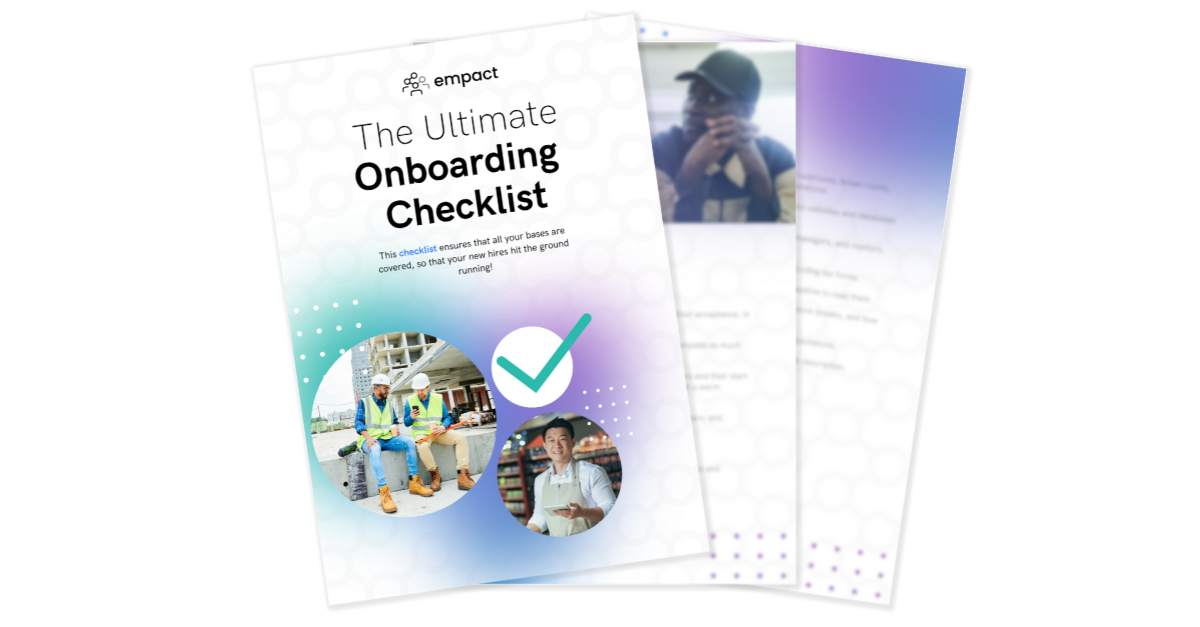Having a good start at a company plays a significant role in the professional development of employees. Many HR professionals know that getting employees used to a new role is not something that occurs overnight but rather begins during the recruitment and hiring process.
But what happens as soon as an employee gets hired for a position? The answer is quite simple, onboarding.
Table Of Contents
- What is onboarding?
- Why is onboarding important?
- What is the purpose of onboarding?
- Onboarding process: step by step
- What is a good onboarding process?
- Consider the journey that onboarding is part of
- How long does onboarding take?
- Onboarding checklist: standardize your onboarding
- Onboarding deskless and frontline workers
- Onboarding at scale
What is onboarding?
Onboarding is the process of getting new employees acquainted with the company and their roles over a period. The process consists of a series of actions and activities that give new employees a sense of belonging and an understanding of the company and its culture. During the onboarding process, employees get to learn about their roles, colleagues, and the unique opportunity to access tools they will find useful to do their job.

Though onboarding is often mistaken for orientation, it is important to note that orientation is a small part of the onboarding process and a one-time event that occurs for a couple of hours. In contrast, onboarding ranges from several days to weeks or even longer. Its outcome is related to what new employees think about your company and whether they choose to stay within their first six months.
Why is onboarding important?
In the current economy, organizations cannot gamble on losing employees to subpar onboarding processes; thus, its importance should not be overlooked. When an organization deprioritizes onboarding, it not only leaves employees feeling dissatisfied and demotivated but also supposes a huge loss as the entire process of finding a replacement can be costly — not counting the resources spent to train or compensate the employee that was hired. So, companies must invest in making the employee onboarding experience remarkable.
When new employees experience good onboarding, the benefits that a company gains are endless. For instance, new employees will settle into their roles and reach full productivity quicker, they will start producing value for the company immediately, and the company will witness a significant increase in employee retention.
What is the purpose of onboarding?
Employee onboarding has many purposes, and it all depends on your needs. One of the purposes of onboarding is that it allows your company to stay connected with new employees from the moment they sign a contract. This way, new hires can get most of their paperwork done before starting the job and get introduced to their team, thereby lessening the stress level that a first day entails.
Another purpose of onboarding is that it permits new hires to educate themselves and get familiarized with your organization and their respective colleagues. Whether you disclose your company’s mission, vision, values, or other aspects you deem necessary, by the time the new hires get all the details about your company, they will no longer feel like outsiders.

Onboarding also provides clear expectations for new hires. This means when the onboarding process starts, it must communicate the responsibilities expected from new employees, be they cultural or work responsibilities.
An additional purpose of onboarding is that it facilitates the right training for new employees. The quality of your onboarding program is a factor that is linked to your chances of retaining your employees for an extended period. When new hires have a positive onboarding experience, it makes way for them to become productive quickly.
Lastly, onboarding serves as the main resource for new employees to do their job well. Ideally, your onboarding should comprise a list of employee resources – it can include physical resources like laptops and workspace materials, or knowledge resources such as training programs and online company directories. Once new employees receive these lists, they will be able to work effectively when they are on their own or when the colleagues they work closely with are not available.
Onboarding process: step by step
There are a few ways to approach the onboarding of new employees. You can opt to hand out a welcome package, arrange a team dinner or lunch with the rest of the team or even prepare a presentation. Whatever you decide, you will not go wrong.
Best practices for a good onboarding process
To get the most out of the process. these best practices will assist you in making a good impression on the new hires.
1. Maintain frequent communication with the new hires
Ensure that your communication with the new employees begins before their start date. You can do this by preparing a welcome package and sending your employee handbook well in advance. This way you show how much you look forward to having them on board.
2. Lay out a detailed plan during the first week
There will be uncertainties during the first day on the job. As it is up to you to prove how prepared you are to have them on board, ensure there is a plan for their first few days and check all the boxes – from setting up their workstation to informing the rest of the team and department about the new employees.
3. Be open and welcoming
We encourage you to give the new employees a company walkthrough and introduce them to their respective co-workers at nearby desks. Then, schedule a team lunch so the new hires get acquainted with the rest of the team, and ensure that their manager meets with them regularly during the first week. It is also essential to provide the new hires with a checklist or schedule with adequate onboarding activities.
4. Stay consistent
Remember that the onboarding process does not conclude after the first week. Ensure that the new employees always have meaningful work on their hands to help build confidence. Afterward, check in with the new hires and their manager after two weeks and at the end of their first month to show support in case they require further assistance.
Once these onboarding steps are executed, you will notice how much of a difference your onboarding program makes in successfully retaining and engaging new employees.
Preboarding: before the first day
Before embarking on the process of onboarding new employees, there is a previous step that you must consider, preboarding. The aim of preboarding, which is the period before new employees accept your job offer and their first day at your company, is to use the time to familiarize new hires with their roles and your organization so that they are ready to get things going from day one.
Carrying out preboarding allows you to share your mission, vision, values, and culture with the new employees before they join your team. It also allows new employees to feel comfortable and ready to embrace their onboarding, orientation, and induction period. Preboarding also offers a valuable opportunity to complete all admin tasks in advance so that the new hires can focus on meeting the team on their first day instead of completing endless tax forms and non-disclosures. Lastly, preboarding helps you engage new hires from the moment you hire them, thereby allowing them to begin developing relationships and emotional attachments before their first day, reducing time to productivity and boosting employee engagement, motivation, and retention.
Plan the first week
The first week of onboarding is about setting the tone for what the rest of the new employees’ time at your company will look like. It is important to plan and make things right so that the new hires can jump into the position and start contributing right away.
.png?width=481&height=481&name=Add%20a%20heading%20(5).png)
To succeed with your plan, we encourage you to send an introductory email to your staff about the new hires. It gives some background about qualifications, previous experiences, and personal and professional information. Planning the first week also gives you time to explain what is expected regarding work hours, duties, and everyday things. If these expectations are not explained, the new employees can form their habits, and it can become challenging to change certain habits moving forward.
Once these expectations have been presented and the new hires get an overview of what their job entails, it is recommended to leave room for new employees to acknowledge the information that was provided to them and, if they wish, engage in a brief interaction with members of your staff that reached out to them. By the end of the first week of onboarding, reviewing what went down will ensure that no topic goes unanswered, as well as give new employees a chance to discuss how things are going so far.
Orientation: first day on the job
A good onboarding requires even better orientation. During this key stage of the onboarding process, your HR department must conduct a set of activities such as employee paperwork, office tour, employee access, system logins, and passwords.
The first day of orientation is a crucial part of making new employees feel welcome and comfortable. Whether you choose to show a short welcome video or go as far as presenting the new hires with a welcome pack, your approach will be well received.
First week
All successful companies have a clear orientation process that goes beyond the first day. There are many ways to approach it, but these simple processes will help your orientation program lead to more engaged and productive employees who stay longer.
Gathering ideas from team members that have been through your onboarding program is a good start. Your existing employees who have already experienced your program know best what they liked about it, what needs to improve, and so on. Thus, asking for their input will help you improve things for the next employees.
Having and sharing a comprehensive first-week agenda that maps out the first week for new employees helps them prepare for day one. Additionally, make sure to keep relevant parties informed since the responsibility of onboarding new employees is not exclusive to HR.
It is also encouraged to be upfront and honest about your company culture and values. It allows an honest dialogue throughout the first week and it gives new hires an idea of how to build a social network within your company. You should also arrange a buddy system where each employee is assigned a work buddy whose role is to make the new hire feel welcome, guided, and supported within the role they are in.
Once the new hires have gone through the orientation program, the employees will be ready for training. By doing this, the new employees will be prepared with the tools to actively contribute to the success of their department and, subsequently, of your company.
Keep it up and check-in
After going through the most intense period of your onboarding program, you still need to be supportive of the new employees. Providing ongoing learning or assistance helps them become the independent team members you wish for. To do this, we suggest scheduling regular check-ins, be they weekly, monthly, or quarterly. These serve as an opportunity to get in dialogue with the new hires to ensure that they are comfortable and happy to be on board your company.
.png?width=540&height=540&name=Add%20a%20heading%20(6).png)
Remember that these regular check-ins are what determine whether new employees become long-term, productive employees or those who contribute to your percentage of employee turnover. So, it is important to acknowledge any of their contributions from early on and enquire about any additional training or support for job-specific duties.
What is a good onboarding process?
For you to successfully bring new employees into your business, explain your company culture, and offer support, you need to have a good onboarding process in place. This activity of integrating new hires into your business and helping them get familiarized with your goals and processes allows new employees to integrate well into your daily office routine and ensures that they are introduced to your company policies, terms and conditions of their employment, and regular duties and responsibilities.
To make new employees integrate into your team quickly and effectively, your onboarding process must provide a good experience. Since the first few weeks are crucial, your onboarding process should address these considerations.
- What the new employees must know about your company culture and vision.
- How can the HR team and respective managers help new hires settle in smoothly.
- The goals and responsibilities of the job.
- How some of the colleagues can assist, especially anyone in a similar role.
- How you will go about conducting their performance.
- The habits of the company.
Whatever you choose to include in your process is completely up to you. The most important aspect is ensuring these considerations are considered as they allow your business to have productive and happy employees. Check out our blog post "How to create an onboarding process" here to learn more on the subject.
Consider the journey that onboarding is part of
The length of onboarding varies across organizations, and it has been proven that companies that provide an onboarding experience beyond the 90-day mark achieve better outcomes. Many things can happen from the moment new employees accept an offer of employment to when they become integrated members of an organization.
If you invest in your new employees, chances are that they will stay longer, contribute more, and influence other newcomers. So, prioritizing the three main phases of onboarding – preboarding, orientation, and integration – will only be effective if these components are present and functional.
.png?width=653&height=653&name=Add%20a%20heading%20(8).png)
Your HR department is not the sole responsible for committing to the journey that onboarding is a part of. Your organization has a say in how much value should be added to each phase of the onboarding journey to reduce the impact of lack of employee engagement, time-to-productivity, and retention.
Developing an effective onboarding strategy and onboarding timeline takes time and effort. But retaining new hires and high-performing employees in your organization is worth the investment.
How long does onboarding take?
Onboarding is a process that can span over the first days, weeks, or months of a new employee’s journey. Most HR experts agree that it should take at least three months. But, if onboarding is extended throughout the employee’s first year, then it positively impacts and increases employee engagement and retention.
There is no formula for a standardized onboarding process as what matters is that your onboarding is tailored to your company and employee needs. The duration of optimal onboarding for any company is based on whether the numerous phases of onboarding are executed. These phases are:
- Orientation: the phase where new employees are introduced to your organization, senior management, and colleagues.
- Role Training: dedicated to teaching new employees about their daily tasks, technical training, and on-site safety training.
- Role Transition: it is where new employees are assigned a buddy, giving the initiative to learn growth and improvement strategies, and effective communication.
- Ongoing Development: the point where you create a long-term plan, set milestones, offer competency assessment, and track progress for the new employees.
Understanding these phases will help you create a strong company strategy to engage new employees, and improve retention, and inclusion in your company’s culture and procedures. If you want your new employees to become familiar with your company culture, know and understand your policies, procedures, and technology, and master what they need to know promptly, then the length of your onboarding will determine the impact it has on employee engagement and retention.
Onboarding checklist: standardize your onboarding
Carrying out an onboarding starts before new employees sign their work contract. Having an onboarding checklist gives you a structured schedule that allows you to prioritize the most important aspects of welcoming new employees. It is your best chance to make a strong impression as an organization that is efficient, organized, and thoughtful.
To improve the employee experience for new hires, we suggest you consider the procedures on this checklist. If you want the checklist in a PDF, Word or Excel file, you can download the ultimate onboarding checklist here – your HR department will appreciate it.
Preboarding
This phase is where you ensure that your new employees understand the next steps and expectations leading into their first day. Here are some of our suggestions:
- Send a welcome email with the offer letter and secure their acceptance, in writing, of the job offer.
- Prepare all necessary paperwork and have new hires complete as much as possible in advance online.
- Inform your current employees of incoming team members and their start dates. Then encourage them to greet the new arrivals with a warm welcome.
- Set up accounts, grant required access levels, install software, and prepare a physical or virtual workstation.
- Build their profile in your human resources system.
- Assign a buddy or mentor to personally welcome the new hire and provide “whom to call” information for any issues that arise.
First day on the job
Here, your priority is to introduce your new employees to the company and familiarize them with the workspace. To achieve this, we suggest you do the following:
- Conduct a tour of the office and point out the restrooms, break rooms, kitchens, meeting spaces, and individual workstations.
- Ensure that the employee can access all required websites and databases and knows how to get IT support.
- Briefly introduce new employees to their team, managers, and mentors. Provide an org chart and contact information.
- Complete any necessary new hire paperwork, including tax forms.
- Distribute employee handbooks and review the deadline to read them.
- Outline company policies, including lunch breaks, work breaks, and how to request time off.
- Review the company mission, goals, culture, and expectations.
- Meet individually with each new hire to review the job description, compensation, and benefits for their new job.
First week on the job
In the first week of employment, you want your new employees to transition into the training phase of the onboarding process. You can do this in the following way:
- Review work assignments.
- Set short-term goals and performance goals.
- Schedule one-on-one check-ins.
- Plan social and team-building activities.
First month on the job
Once you reach the first month of onboarding, move through the training program using a combination of formal training, shadowing, and supervised practical experience. Make sure you do the following:
- Complete training on policies, procedures, company values, and culture.
- Conduct regular check-ins to answer questions, clarify policies, listen to feedback, and offer encouragement.
Ongoing check-ins
After you have made the new employees succeed in their first month, you should support them in ongoing learning and help them become independent team members. Some of the ways to do this are as follows:
- Schedule regular check-ins every month.
- Continue training for job-specific duties.
- Check in with employee mentors to get feedback on new hire performance and gaps in training.
- Get feedback from new employees about how the onboarding process prepared them for their new role and affected their new hire experience.
By providing a copy of this checklist to your HR department, your new employees will be well-prepared, and they will know what to expect when they start working for your organization.
Onboarding deskless and frontline workers
After the immense crisis that affected the entire world, the rise of hybrid and remote work has made way for more organizations to think of innovative ways to onboard new employees that might not even step foot into the office space. Though beneficial for the average employee, how do you ensure that new employees feel welcome and supported from a distance?
Automating your onboarding process gives you the flexibility to streamline your onboarding workflow and communicate the process and all information involved as clearly as possible for remote workers. To do so, you must make the new employees get acquainted and comfortable with your company's communication tools as quickly as possible.

There are multiple ways to approach this, but we suggest setting up video calls or virtual meetings with relevant managers and team members and considering assigning them an onboarding buddy they can reach out to with any questions. Using onboarding software facilitates this as it is an ideal tool for organizing the process and it can be easily set up by your HR department. Additionally, the remote onboarding process can involve additional steps like sending your company gear to remote workers, thereby ensuring compliance with the laws.
Technical onboarding
The benefit of using software tools to onboard new employees is that they accelerate the process for your company, and they also contribute to the efficiency of the new employee’s integration process. It is important to be thorough and organized during the onboarding process – not only for logistical reasons but also because it is a key component to acquiring qualified talent.
Opting for the use of technology to onboard new employees can help streamline communication, facilitate training, ensure compliance, and manage necessary paperwork. It also helps make the onboarding process easier for your HR department as you incorporate automation and notifications into their workflow, ensuring that all tasks are completed promptly.
By making your onboarding technical, you create and implement a consistent and comprehensive onboarding strategy that improves the efficiency and productivity of your organization as your new employees are empowered to step into their roles with comfort and confidence. A poor technical onboarding process can delay the incorporation of new employees, but an established onboarding process helps you deliver a fantastic experience and a faster ramp-up time for every new hire.
Practical onboarding
Great onboarding involves more than on-the-job skills training. To create an exceptional onboarding experience for new employees, you should consider these valuable strategies. They will help you excel with aspects such as people, learning, and process components of an onboarding program. It will allow you to create an onboarding program that engages any workforce.
- Set up their workspace with everything they need, such as ID badges, passwords, handbooks, and so on.
- Anticipate that new employees require some time to settle in, so communicate your goals and expectations early and often.
- Assigning a mentor or buddy, having regular check-ins, and involving the team are also recommended.
- Acclimate the employee to the company's processes, culture, norms, and goals. Engage them by fostering supportive relationships with co-workers and management.
- Finally, learning how new employees operate is important, so try to understand their expectations, management style, and work style.
Onboarding at scale
Making your onboarding program succeed significantly improves employee engagement and retention. An effective onboarding process that works at scale helps you create a sense of belonging. But to get there, you must consider these considerations.
1. Make sure everything you do is set up for success
Working in an organization that is continuously hiring means that an effective onboarding program is essential. Make sure everything you do is set up for success, but before getting there, you must find out how new employees will fit in with your organization and then decide what approaches will best help them feel welcomed and comfortable from their start day.
2. Provide new employees with a sense of belonging
While it may be easy for some employees to get acquainted with their manager and direct team, creating engagement and a sense of belonging in an organization, especially across branches and countries, is challenging. So, work on how to create a company culture that connects people locally and globally.
The ideal approach is to get people involved in developing your onboarding program. It requires creating clear roles and responsibilities, and it involves connecting with your HR department so that new employees get a consistent experience.
3. Avoid overloading new employees with information
We all know that starting a new job means getting overloaded with information, which can be overwhelming. To facilitate things for new employees, you should map out the first year of onboarding by creating a clear and consistent journey. This period is about giving employees what they need at a specific moment rather than everything at once.
4. Keep track of your progress and measure what counts
What is important here is that you focus on your current onboarding process. See what works, what needs improvement, and so on. Then, focus on the overarching engagement and dive into the specific elements you want to drive through your onboarding checklist and plan. Identify what to measure and you will get a better picture of how your onboarding is going.
Leveraging the right tools to onboard at scale improves your onboarding process. One of the most significant benefits of onboarding at scale is how much time it saves you and your team. An onboarding strategy founded on a well-structured checklist and plan empowers you to add value to the lives of new employees while increasing your chances of employee engagement and retention.
Curious to know more?
To learn more about how Empact strategically designs employee engagement apps that adapt perfectly to your requirements, feel free to contact us. We will happily assist you in creating a business case and provide a solution that fits your organization.
Onboarding is the process of getting new employees acquainted with the company and their roles over a period. The process consists of a series of actions and activities that give new employees a sense of belonging and an understanding of the company and its culture. During the onboarding process, employees get to learn about their roles, colleagues, and the unique opportunity to access tools they will find useful to do their job.

 33 min read
33 min read


